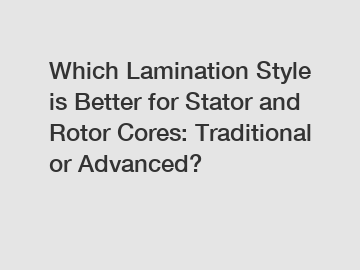Which Lamination Style is Better for Stator and Rotor Cores: Traditional or Advanced?
When it comes to designing efficient electric motors, choosing the right lamination style for stator and rotor cores plays a crucial role. Engineers continuously seek the perfect balance between performance, cost-effectiveness, and durability. In this blog, we will delve into the age-old debate of traditional versus advanced lamination styles for stator and rotor cores. By exploring the benefits and limitations of each approach, we aim to help you make an informed decision for your motor design needs.
Traditional Lamination: A Time-Tested Approach.
For decades, engineers have relied on traditional lamination techniques to produce electric motors. This tried and tested method involves the stacking and staking of individually insulated laminations to create stator and rotor cores. The lamination thickness and stacking configuration affect factors such as magnetic flux, eddy current losses, and overall motor efficiency.

Advantages of Traditional Lamination:
1. Cost-Effectiveness: Traditional lamination methods are well-established, making them more accessible and cost-effective for manufacturers.
2. Reliability: These techniques have stood the test of time, ensuring the reliability and durability of motor cores.
3. Simplicity: Traditional laminations are relatively straightforward to manufacture and assemble, making them ideal for simpler motor designs.
Limitations of Traditional Lamination:
1. Eddy Current Losses: Due to their assembly, traditional laminations are more prone to substantial eddy current losses, which can lower motor efficiency.
2. Magnetic Flux Imbalance: The presence of slots and teeth in traditional lamination designs can cause an uneven distribution of magnetic flux, leading to reduced motor performance.
3. Limitations in Core Shape: Traditional lamination styles often restrict engineers to standard core shapes, limiting design flexibility.
Enter Advanced Laminations: A Modern Twist.
In recent years, advancements in materials, manufacturing techniques, and design strategies have paved the way for advanced lamination styles. Advanced lamination technologies aim to overcome the limitations associated with traditional methods, seeking to improve motor performance and efficiency.
Advantages of Advanced Lamination:
1. Enhanced Efficiency: Advanced lamination styles use specialized techniques to minimize eddy current losses, resulting in improved motor efficiency.
2. Flux Concentration: Advanced designs allow for optimized magnetic flux paths, reducing losses and enhancing overall motor performance.
3. Design Flexibility: Advanced lamination styles offer engineers greater freedom to explore unique core shapes, enabling customized motor designs for specific applications.
Limitations of Advanced Lamination:
1. Manufacturing Complexities: The complexity of advanced lamination techniques often requires specialized manufacturing processes, adding to the production costs.
2. Limited Availability: Advanced lamination technologies are relatively new, making them less accessible in terms of availability and expertise in some regions.
3. Uncertainty in Long-Term Performance: As advanced lamination styles may lack extensive long-term reliability data, some engineers may be hesitant to adopt them for critical applications.
Choosing the Right Path for Your Motor Design:
Selecting between traditional and advanced lamination styles depends on various factors such as the desired motor performance, overall cost, and application requirements. Established industries may find traditional lamination techniques sufficient for their needs, while emerging sectors seeking improved efficiency may opt for advanced approaches. It is crucial to evaluate the trade-offs and consult with industry experts to ensure the best decision for your motor design.
Conclusion:
The eternal debate between traditional and advanced lamination styles for stator and rotor cores reveals the complex considerations involved in motor design. While traditional techniques offer reliability and cost-effectiveness, advanced approaches promise enhanced efficiency and design flexibility. Ultimately, the ideal choice depends on individual requirements, balancing the benefits and limitations associated with each method. With advancements in technology and further research, the future of lamination styles holds promise for even more efficient and innovative electric motor designs.
Contact us to discuss your requirements of Bus motor core, injection moulded insulation stator, stator and rotor in dc motor . Our experienced sales team can help you identify the options that best suit your needs.
344
0
0


Comments
All Comments (0)